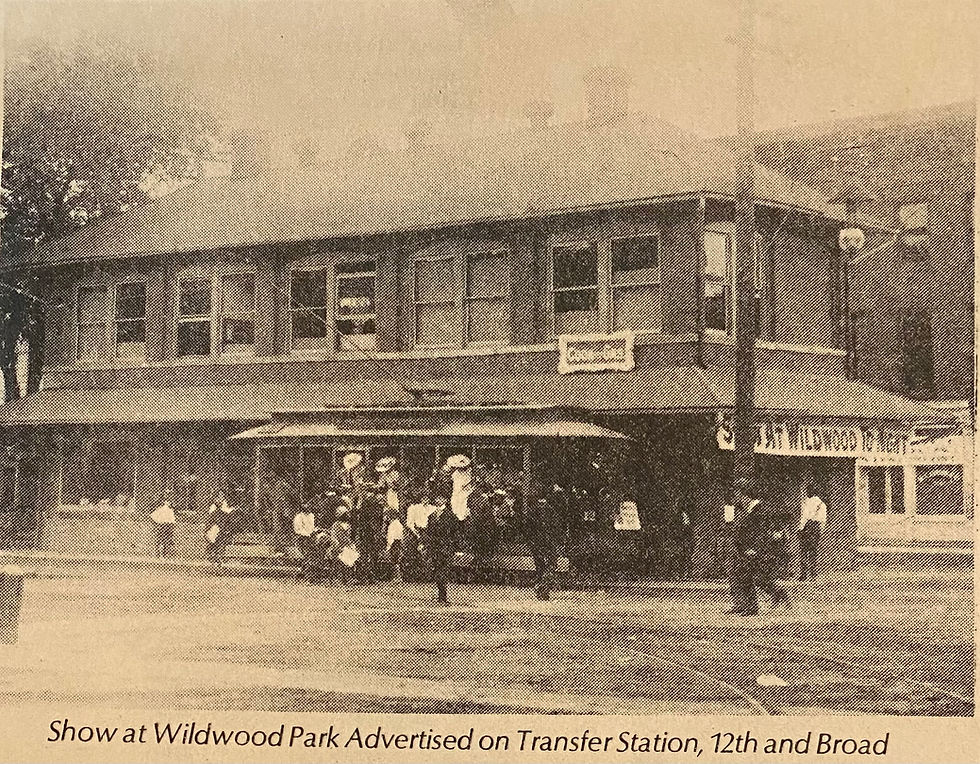SOURCE: Pleasures Simpler Back Then, But Taken Seriously, by John Coombes,
Columbus Ledger – Enquirer, May 28, 1961.
Riding the Belt
In the 1890's the electric streetcar made its halting debut in Columbus and simultaneously furnished the city's small boys, beaus and belles with one of their principal pastimes-riding the cars. The electric cars were the only community transportation to North Highlands Park-then being developed under the direction of British landscape artist J. Forsyth Johnson. The Dummy provided transportation to Wildwood Park and Wynnton.
It was always in demand for trolley parties, dance parties, family reunions, cooking lectures, and revivals. But for all its popularity it never lost its character. Some dummies were boldly emblazoned with such names as Marguerite, Eloise, or Little Jake; while others grew positively uppity, were equipped with as much as six wheels, two cow catchers and other paraphernalia. The Columbus dummy, however remained anonymous, the delight of small boys and courting couples. Only the older folk know the part those docile little cars played in the pleasures of a bygone era.

Stage Spectacles
Theater in Columbus in the 1880's was expansive, lusty and varied. On the stage of the Springer Opera House appeared the leading stars of the American theater; and the Springer might quite easily have challenged the claim of the St. Charles Theater in New Orleans that it featured more famous actors than any other theater in the South at that time. Spectacle shows, with ingenious mechanical thrills, were the delight of simpler folk, a locomotive rolling across the stage or a grist mill with splashing water, creaking machinery and flying dust. Vaudeville and burlesque shows also appeared in Columbus.
After 1927 the Three Arts League kept a steady stream of Broadway talent flowing through Columbus. Amateur theatricals too were pursued with enthusiasm and the Columbus Dramatic Club, founded in 1887 performed comedy and farce.

Huntin' and Fishin'
Hunting, the oldest genuinely native sport of the South, had a great following in old Columbus. At the turn of the century a considerable amount of surplus wealth went into hunting clubs and game laws were enacted for the protection of wildlife. When the seasons closed in The Valley, Columbus hunters went further afield and sought more exotic prey in Florida.
In 1887 a party of prosperous businessmen left Columbus aboard the steamer Thronateeska for a three-week fishing and hunting trip at Owl Creek near Apalachicola. This five-man group brought back two deer, a dozen alligators, numerous ducks, game birds, squirrel and barrel after barrel of trout, beam rock, and other fish. Everyone hunted in those days. Fathers taught sons the finer points of quail flushing; and hunting dogs were supported in large numbers. Ordinarily rough men could be extremely sentimental over hunting dogs; they were fed off the choicest meats and scraps, fondled in their old age and their memories cherished after death.
The Southeastern Field Trials at Albany, Ga., which attracted the best dog handlers with the finest bird dogs in the country was attended by scores of spectators from Columbus as anxious to pick up handling tips as they were to observe the sagacity of the dogs. Alabama field sport classics also drew entries from Columbus. With the building of the big hydro-electric dams across the Chattahoochee, fishermen too benefitted and the banks of the great lakes formed by the backed-up waters were to become the favorite haunts of city anglers.

A Football Climate
Through the years Columbus people have taken a growing interest in sports, particularly baseball and football. The football seasons of the 1880's opened in November with the battle of the Uptown and Downtown Clubs. Uptown won in 1888 for the first time in years. Physical education, included in the curricula of Columbus schools as a compulsory subject, did much to interest the younger generation in sports and athletics.
The achievements of Southern football teams then comparatively new to the game boosted the local football following. Intercollegiate football was very closely followed. Georgia Tech began playing inter-collegiate matches in 1892. On New Year's Day 1926 the University of Alabama's Crimson Tide, under coach Wallace Wade, defeated Washington State at the Rose Bowl in Pasadena, Calif., to win the Eastern Western championship; then the University of Georgia trounced Yale thrice within four years. Southern football was soon well and truly established.
The Southern climate too proved an asset to the game. At the Columbus stadium players wearing the lightest of equipment moved against a background of men in shirtsleeves, girls in summer dresses and gallons of ice cream and Coca Cola. Columbus became the venue for more than a few of the important Southern games, was for years the home of the annual Auburn-Georgia game (1916 - 1958) until it was moved back to the universities' campuses.


ILMUTOTO
Toto Togel
Toto Togel
Toto Togel
Toto
Toto Togel
Situs Toto
Toto Togel
Situs Toto
8ANGKAJITU
Slot Online
Toto
Toto
Toto
Toto
Toto
Situs Togel
KIENTOTO
Toto Togel
Toto Togel
KIENTOTO
KIENTOTO
Toto Togel
Toto Togel
Toto Togel
Slot Gacor Hari Ini
Toto Togel
8KUDA4D
Toto Togel
Toto Togel
Toto Togel
8KUDA4D
Toto Togel
Toto Togel
Situs Togel
Situs Toto
Slot Gacor
TITI4D
Toto Togel
Toto Togel
Toto Togel
Toto Togel
TITI4D
Toto Togel
Toto Togel
Situs Togel
Toto Togel
Toto Togel
Slot Gacor